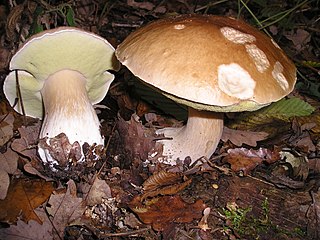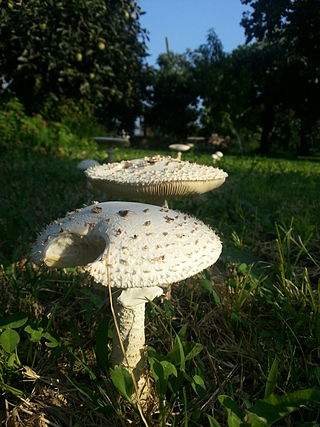
The Boletaceae are a family of mushroom-forming fungi, primarily characterised by small pores on the spore-bearing hymenial surface, instead of gills as are found in most agarics. Nearly as widely distributed as the agarics, the family is renowned for hosting some prime edible species highly sought after by mushroom hunters worldwide, such as the cep or king bolete . A number of rare or threatened species are also present in the family, that have become the focus of increasing conservation concerns. As a whole, the typical members of the family are commonly known as boletes.

Lactarius is a genus of mushroom-producing, ectomycorrhizal fungi, containing several edible species. The species of the genus, commonly known as milk-caps, are characterized by the milky fluid ("latex") they exude when cut or damaged. Like the closely related genus Russula, their flesh has a distinctive brittle consistency. It is a large genus with over 500 known species, mainly distributed in the Northern hemisphere. Recently, the genus Lactifluus has been separated from Lactarius based on molecular phylogenetic evidence.

Boletus is a genus of mushroom-producing fungi, comprising over 100 species. The genus Boletus was originally broadly defined and described by Carl Linnaeus in 1753, essentially containing all fungi with hymenial pores instead of gills. Since then, other genera have been defined gradually, such as Tylopilus by Petter Adolf Karsten in 1881, and old names such as Leccinum have been resurrected or redefined. Some mushrooms listed in older books as members of the genus have now been placed in separate genera. These include such as Boletus scaber, now Leccinum scabrum, Tylopilus felleus, Chalciporus piperatus and Suillus luteus. Most boletes have been found to be ectomycorrhizal fungi, which means that they form a mutualistic relationship with the roots system of certain kinds of plants. More recently, Boletus has been found to be massively polyphyletic, with only a small percentage of the over 300 species that have been assigned to Boletus actually belonging there and necessitating the description and resurrection of many more genera.

The Fomitopsidaceae are a family of fungi in the order Polyporales. Most species are parasitic on woody plants, and tend to cause brown rots. The name comes from Fomitopsis + -aceae.
Lanspora is a genus of marine fungi in the family Phomatosporaceae. The genus was circumscribed in 1986 by mycologists Kevin D. Hyde and E.B. Gareth Jones with L. coronata as the type, and at that time, only species. Lanspora cylindrospora was added to the genus in 2020.
Catatrama is a fungal genus in the family Amanitaceae, order Agaricales. Originally a monotypic genus with Catatrama costaricensis, found in Quercus pilarius forest in Costa Rica. In 2007, the species was reported from Brazil. Since then 2 additional species, one from Australia and one from India have been recognized.

Rossbeevera is a genus of sequestrate (truffle-like) fungi in the family Boletaceae. It was first published in 2012 under the erroneous name Rosbeeva, but was corrected to Rossbeevera in the same issue. The genus was created to contain species formerly placed in Chamonixia, but characterized by having ellipsoid to spindle-shaped spores with 3–5 longitudinal ridges, bluish-green to deep blue fruit body staining reaction, and a thin whitish peridium. The Chinese species R. yunnanensis is the earliest diverging lineage within the genus, and has a close phylogenetic relationship with the bolete genera Turmalinea and Leccinellum.

Lanmaoa is a fungal genus in the family Boletaceae. It was circumscribed by Chinese mycologists Nian-Kai Zeng and Zhu L. Yang in 2015 to contain several species formerly classified in the genus Boletus, as well as the newly described Asian boletes L. angustispora and L. asiatica. The erection of this genus follows recent molecular studies that outlined a new phylogenetic framework for the family Boletaceae. Zeng and Yang named the genus after Chinese naturalist Lan Mao (1397-1476).

Rugiboletus is a fungal genus in the family Boletaceae. It was circumscribed by Chinese mycologists Gang Wu and Zhu L. Yang in 2015 with the alpine species Rugiboletus extremiorientalis from eastern Asia as the type species. Rugiboletus brunneiporus of southern China and India was also described that same year. The erection of Rugiboletus follows recent molecular studies that outlined a new phylogenetic framework for the Boletaceae. The generic name—derived from the Latin stem rugi- ("wrinkled") and Boletus as the mushroom caps are wrinkled and furrowed, unlike any other boletes.

Neoboletus is a genus of fungi in the family Boletaceae, native to holarctic regions. It was circumscribed in 2014 by Italian mycologists Matteo Gelardi, Giampaolo Simonini and Alfredo Vizzini, and further by Chinese mycologists Gang Wu and Zhu L. Yang in 2015. Closely related to the genus Sutorius, members of this genus differ by staining blue when bruised. They have brown pores and lack a reticulated pattern on their stipes. The erection of Neoboletus follows recent molecular studies that outlined a new phylogenetic framework for the Boletaceae. The type species is Neoboletus luridiformis. Five species were added to the genus by Gelardi and Vizzini in 2014.

Glomerellales is an order of ascomycetous fungi within the subclass Hypocreomycetidae (Sordariomycetes). The order includes saprobes, endophytes and pathogens on plants, animals and other fungi with representatives found all over the world in varying habitats.

The genus Saproamanita contains about 24 species of agarics and is one of six genera in the family Amanitaceae. The others are Amanita, Catatrama, Limacellopsis, Zhuliangomyces and Limacella. Saproamanita are the saprophytic species in the Tribe Amaniteae, separately classified from the ectomycorrhizal species in the genus Amanita.
Calcarisporiellales is an order of fungi within the phylum of Calcarisporiellomycota and in the class Calcarisporiellomycetes. It contains 2 known families, Calcarisporiella, and Echinochlamydosporium. The 2 genera each have 1 species.
Adustochaete is a genus of fungi in the family Auriculariaceae. Species produce effused basidiocarps on wood, typically covered in small sterile spines or pegs. The genus was created as a result of molecular research, based on cladistic analysis of DNA sequences, to accommodate two species from Brazil and Mexico that are not closely related to the older and superficially similar genus Heterochaete. Two additional species, from Brazil and China, have since been described.
Tremellochaete is a genus of fungi in the family Auriculariaceae. Species produce pustular or lobed, effused, gelatinous basidiocarps on wood, typically covered in small sterile spines or pegs.
Amphistereum is a genus of fungi in the family Auriculariaceae. Species produce cupulate to effused, leathery basidiocarps on wood. Microscopically, fruit bodies have a dimitic hyphal system. The genus is currently only known from North and South America.
Proterochaete is a genus of fungi in the family Auriculariaceae. The type and only species, Proterochaete adusta, produces thin, effused, corticioid basidiocarps with a smooth or spiny surface on wood. The species was originally described from North America and is also known from northern Europe and Asia.
Crocellina is a monotypic fungal genus in the family Roccellaceae. It contains the single species Crocellina cinerea, a saxicolous (rock-dwelling), crustose lichen that is endemic to Socotra Island in the Indian Ocean. This species was first described in 1882 by Swiss botanist Johannes Müller Argoviensis as Dirina cinerea, and later transferred to genus Roccellina in 1983. Crocellina was circumscribed in 2014 by Anders Tehler and Damien Ernst, following molecular phylogenetic analysis and revision of the Roccellaceae.
Sclerotrema is a genus of fungi in the family Auriculariaceae. The type and only species, Sclerotrema griseobrunnea, produces effused, corticioid basidiocarps on wood with a smooth surface. The species was originally described from Russia and is also known from Canada.

Pseudoschismatomma is a monotypic fungal genus in the family Roccellaceae. It contains the single species Pseudoschismatomma rufescens, a corticolous (bark-dwelling), crustose lichen. This species was first described in 1794 by Christiaan Hendrik Persoon as Opegrapha rufescens. Pseudoschismatomma was circumscribed in 2014 by Damien Ernst and Anders Tehler, following molecular phylogenetic analysis and revision of the Roccellaceae. The genus name alludes to its similarity with genus Schismatomma, particularly S. graphidioides. It differs from this species in having a distinct brown true exciple.











